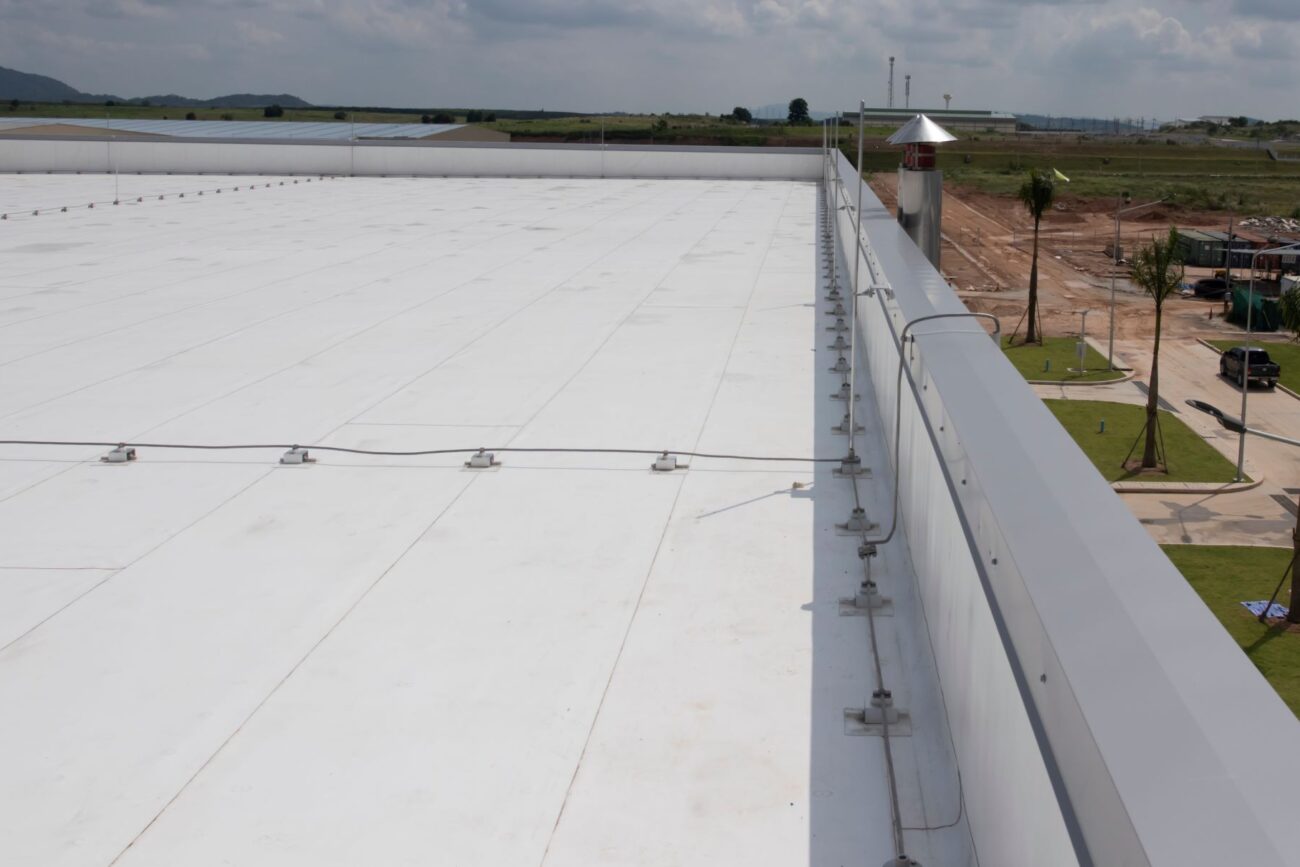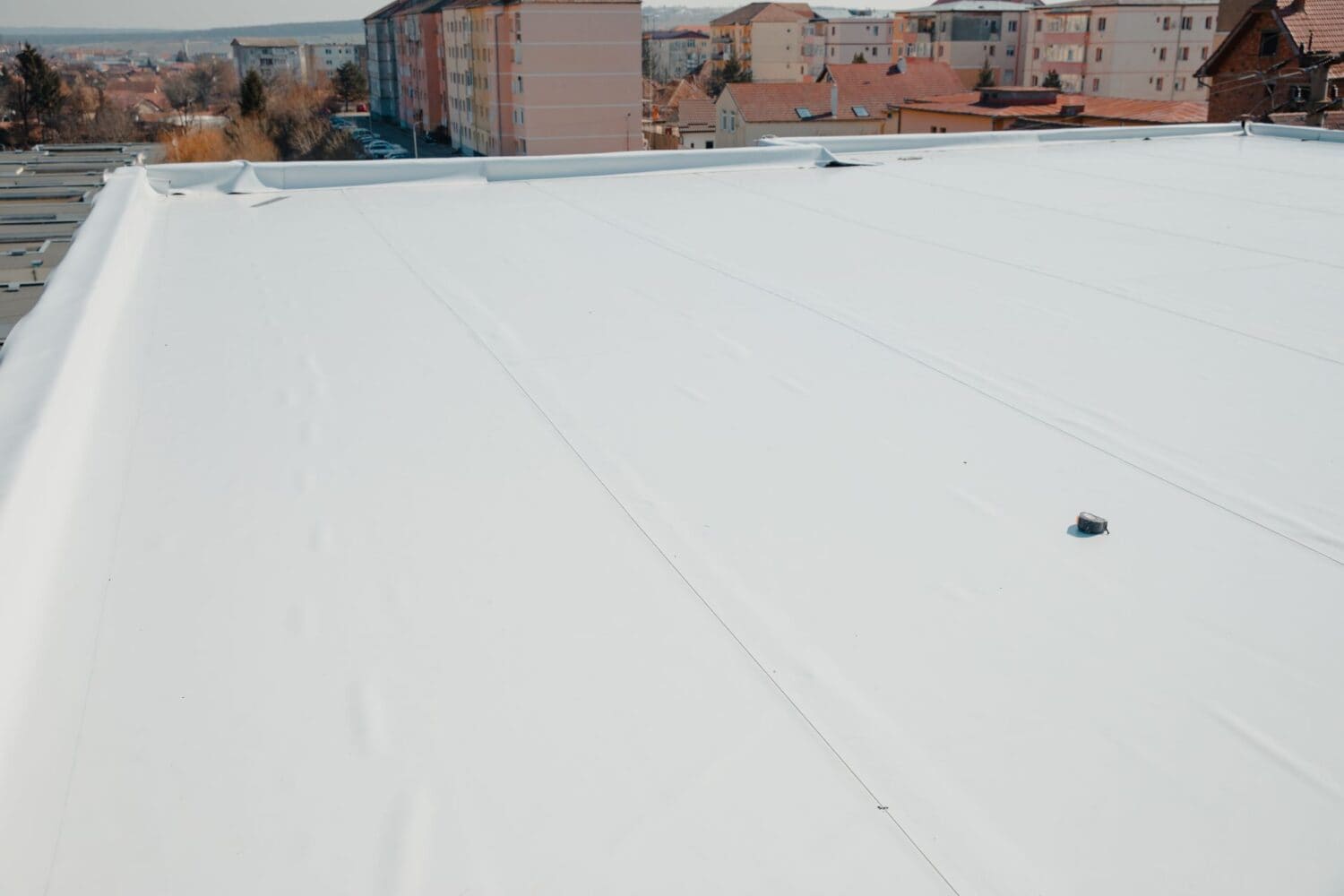When it comes to commercial roofing, choosing the right material can make a huge difference in your building’s longevity, energy efficiency, and overall performance. Two of the most popular single-ply roofing materials on the market today are Thermoplastic Polyolefin (TPO) and Polyvinyl Chloride (PVC). When comparing TPO vs PVC roofing, building owners must evaluate their unique advantages, depending on the specific needs of their commercial properties. Both roofing systems have clear benefits and drawbacks, and understanding the differences between TPO vs PVC roofing can help facility managers, building owners, roofing contractors, and construction professionals make the right decisions on which material offers the best performance for their roofs. We’ll break down the essential differences between TPO and PVC roofing, considering their materials, performance, benefits, and drawbacks to help you determine which option is best for your roofing needs.
What is TPO Roofing?
It’s important to understand what is TPO membrane when evaluating roofing materials. Thermoplastic Polyolefin (TPO) is a single-ply roofing membrane that is popular due to its cost-effectiveness, energy efficiency, and durability. TPO membranes are composed of a blend of ethylene-propylene rubber and polypropylene. The membrane is usually installed in sheets that are heat-welded at the seams to create a watertight, seamless roof. TPO roofing systems are also highly resistant to UV rays. The membrane is typically white, reflecting sunlight and reducing the heat absorbed by the building, which can lead to significant energy savings. In addition to UV resistance, TPO also offers protection against ozone, chemical exposure, and punctures, making it a great option for a range of commercial applications. When considering TPO vs PVC roofing, it’s important to consider the cost-effectiveness of both and the long-term durability of each material. In addition, in terms of energy efficiency, the TPO vs PVC roofing discussion often favors TPO for its ability to reflect sunlight and reduce heat absorption.

TPO roofing being installed
Key Benefits of TPO Roofing
- Energy Efficiency: The highly reflective surface of TPO helps reduce cooling costs by minimizing heat absorption.
- Cost-Effective: TPO membranes are generally more affordable than other single-ply roofing materials.
- Durability: TPO is resistant to tears, punctures, and impacts, making it ideal for roofs that experience heavy foot traffic.
- Easy Installation: TPO is lightweight and easy to install, which can lead to shorter project timelines and reduced labor costs.
- Environmental Impact: TPO roofing systems are often seen as more environmentally friendly due to their recyclability and energy-saving properties.
What is PVC Roofing?
Polyvinyl Chloride roofing, known as PVC, is known for its excellent chemical resistance and longevity, making it a great choice for facilities exposed to harsh environments. PVC roofing material is an ideal choice for commercial buildings, especially those in industrial settings. PVC, like TPO, is a single-ply roofing membrane. PVC roofing membranes are made from a thermoplastic material composed of two layers of PVC with a reinforcement layer, usually polyester or fiberglass, sandwiched in between. PVC roofing is highly durable and performs exceptionally well in environments where the roof is exposed to harsh chemicals, fats, oils, and other substances. It’s commonly found on commercial buildings such as restaurants and food-processing facilities due to its ability to resist grease and other chemical spills. PVC membranes are available in a variety of colors, although white or light colors are most common due to their energy-efficient properties. Similar to TPO, PVC membranes are installed by heat-welding the seams, creating a waterproof barrier that’s both strong and flexible. When comparing TPO vs PVC roofing, PVC is the winner when it comes to superior chemical resistance and fire protection.

PVC roofing membrane on a commercial roof
Key Benefits of PVC Roofing
- Chemical Resistance: PVC excels in environments where the roof is exposed to harsh chemicals, oils, or greases, making it ideal for restaurants and industrial facilities.
- Longevity: PVC roofs are known for their long lifespan, often lasting 20 years or more when properly installed and maintained.
- Fire Resistance: PVC has excellent fire-resistant properties, making it a safer option for certain buildings.
- Strength: The reinforced layers of PVC membranes give them high resistance to punctures and tears, making them durable under tough conditions.
- Energy Efficiency: PVC roofs reflect sunlight, reducing heat absorption and helping to lower cooling costs during warmer months.
Difference Between TPO and PVC Roofing
When deciding between PVC vs TPO, the choice often comes down to factors like cost, environmental resistance, and the specific needs of the building. When it comes to chemical resistance between TPO vs PVC roofing, PVC often outperforms TPO in industrial settings. PVC’s added layers of reinforcement make it better suited for environments with chemical exposure, so it’s important to note that when comparing TPO vs PVC roofing. Below we break down the primary differences between TPO and PVC roofing:
Chemical Resistance
- PVC: PVC is the clear winner when it comes to chemical resistance. It can withstand exposure to grease, oils, and other harsh chemicals that would degrade other roofing materials. This makes it the go-to choice for facilities such as restaurants, airports, and chemical plants.
- TPO: While TPO offers some chemical resistance, it is not as robust as PVC in environments with heavy chemical exposure. TPO is more suited for general commercial applications where chemical resistance is not a primary concern.
Durability and Strength
- PVC: PVC roofing membranes are reinforced with polyester or fiberglass, providing plenty of strength and resistance to punctures, tears, and impacts. This makes PVC a better option for buildings that experience harsh weather conditions or heavy foot traffic on the roof.
- TPO: TPO roofs are also durable, but they are more prone to punctures and tears than PVC, particularly in regions with extreme temperatures or significant roof traffic. While TPO membranes can withstand impacts, they may not last as long as PVC in harsh environments.
Energy Efficiency
- TPO: TPO roofing is widely regarded for its energy-efficient properties, especially in hotter climates. Its white, reflective surface helps reduce heat absorption, keeping buildings cooler and potentially lowering energy costs.
- PVC: While PVC roofing can also provide energy efficiency, it doesn’t always match the reflective capabilities of TPO. That being said, PVC membranes are still a solid choice for energy savings, especially when installed in lighter colors.
Environmental Impact
- TPO: TPO roofing systems are generally considered more environmentally friendly due to their recyclability and energy-saving features. The manufacturing process of TPO also tends to have a lower environmental footprint compared to other roofing materials.
- PVC: PVC has faced scrutiny for its environmental impact, particularly regarding the chemicals used in its production. PVC is more difficult to recycle and can release harmful chemicals when disposed of improperly. However, changes have been made to improve the environmental performance of PVC, and some manufacturers offer recyclable PVC products.
Cost
- TPO: TPO roofing is typically more affordable than PVC, both in terms of material costs and installation. This makes it an attractive option for building owners who want a cost-effective solution without sacrificing too much in terms of performance.
- PVC: PVC roofing is generally more expensive than TPO due to its enhanced chemical resistance, durability, and longevity. However, the higher upfront cost can be justified by the longer lifespan and lower maintenance requirements of PVC roofs.
Installation
- TPO: TPO roofing systems are easier and quicker to install compared to PVC, which can result in lower labor costs. TPO’s lightweight nature makes it easier to handle and apply, particularly on large commercial roofs.
- PVC: PVC roofing requires more skill and precision to install due to its reinforced layers. While this results in a highly durable and reliable roofing system, the installation process is often more time-consuming and costly.
Benefits of TPO and PVC Roofing
Benefits of TPO Roofing
- Energy Savings: TPO’s reflective surface helps reduce cooling costs in warm climates, making it a popular choice for energy-conscious building owners.
- Affordability: TPO offers a lower upfront cost compared to PVC while still providing solid durability and protection against the elements.
- UV and Heat Resistance: TPO performs well in sunny climates, resisting UV radiation and heat absorption that can degrade other roofing materials.
To summarize, TPO roofing offers several benefits, including energy savings due to its reflective surface that reduces cooling costs in warm climates and affordability with a lower upfront cost compared to PVC. Additionally, TPO is highly resistant to UV radiation and heat, making it an excellent choice for sunny regions.
Benefits of PVC Roofing
- Chemical Resistance: PVC’s ability to withstand exposure to harsh chemicals makes it the best choice for industrial facilities, restaurants, and other buildings where spills and chemical exposure are a concern.
- Long Lifespan: PVC roofs are known for their longevity, often outlasting TPO roofs by several years when properly maintained.
- Fire Resistance: PVC is naturally fire-resistant, adding an extra layer of protection for buildings in fire-prone areas.
So, when considering TPO vs PVC roofing, the decision comes down to the building’s environment. PVC roofing offers plenty of chemical resistance, making it ideal for industrial facilities and buildings exposed to harsh chemicals, while also providing natural fire resistance for added safety. With a long lifespan that often surpasses TPO roofs, PVC is a durable and reliable option for various commercial applications.
How to Select Between TPO and PVC Roofing
Choosing between TPO vs PVC roofing requires consideration of factors such as budget, chemical exposure, and climate conditions. Here are some considerations to help you decide:
When to Choose TPO Roofing
- You’re seeking a cost-effective roofing solution with good energy efficiency.
- Your building is located in a warm climate where reducing heat absorption is a priority.
- Chemical resistance isn’t a primary concern for your building’s operations.
- You need a roofing system that’s quick to install, minimizing disruption to your business.
When to Choose PVC Roofing
- Your building is exposed to harsh chemicals, oils, or greases, such as in a restaurant or industrial setting.
- You’re willing to invest more upfront for a longer-lasting roofing system.
- Durability, strength, and fire resistance are crucial considerations for your building.
- You need a roofing system that can withstand heavy foot traffic or harsh weather conditions.
Conclusion
When comparing TPO vs PVC roofing, it’s easy to see that both materials offer unique benefits, and the choice you make ultimately depends on the specific requirements of the building. TPO is more affordable, energy-efficient, and easy to install, making it a great option for many general commercial applications. On the other hand, PVC offers chemical resistance, fire protection, and durability, making it ideal for industrial facilities and buildings exposed to harsher conditions. By understanding the key differences between TPO and PVC roofing, you can make the best decision to suit your building’s requirements and long-term goals.

